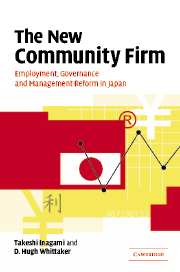Book contents
- Frontmatter
- Contents
- List of figures
- List of tables
- Preface
- Acknowledgements
- Part 1 The End of the Community Firm?
- 1 Company as Community
- 2 The Classic Model: Benchmark for Change
- 3 Change and Continuity
- 4 Company Professionals and Creative Work
- 5 Corporate Governance and Managers' Ideologies
- 6 Consolidated Management and Quasi Internal Labour Markets
- 7 Summing Up
- Part 2 Hitachi: ‘Here, the Future’
- Part 3 The Reformed Model
- Appendix: Changes in Job Tenure
- References
- Index
3 - Change and Continuity
Published online by Cambridge University Press: 22 September 2009
- Frontmatter
- Contents
- List of figures
- List of tables
- Preface
- Acknowledgements
- Part 1 The End of the Community Firm?
- 1 Company as Community
- 2 The Classic Model: Benchmark for Change
- 3 Change and Continuity
- 4 Company Professionals and Creative Work
- 5 Corporate Governance and Managers' Ideologies
- 6 Consolidated Management and Quasi Internal Labour Markets
- 7 Summing Up
- Part 2 Hitachi: ‘Here, the Future’
- Part 3 The Reformed Model
- Appendix: Changes in Job Tenure
- References
- Index
Summary
From the mid-1980s there was a groundswell of opinion that the Japanese community firm and employment model had outlived its day, and that a thoroughgoing overhaul was necessary. This now appears to be the official Japanese government view; without deregulation of labour policy, diversification of employment patterns and greater labour mobility, Japan will be unable to regain its vitality in the twenty-first century. We will not debate the pros and cons of the community firm and labour mobility here (but see chapter 14). Instead we will examine which parts of the model described in chapter 2 have changed since 1975, which have not, and why, focusing in this chapter on lifetime employment, nenko wages and promotion and long-term skill formation. 1975 is chosen because it marks the definitive break of the postwar high growth period, during which the classic model was constructed. The robustness of the model was tested in the mid-1970s following the first oil crisis, in the mid-1980s post Plaza Accord yen appreciation, and even more seriously, since the late 1990s.
The analysis is based on a number of surveys, mostly carried out by research groups chaired by Inagami. The surveys will be briefly introduced as they appear. Before the analysis, some brief background information on changes in the labour force and labour law will be helpful.
Background
Employment structure changes, 1975–2000
Between 1975 and 2000 the labour force population increased by 27%, from 53.2 million to 67.7 million.
- Type
- Chapter
- Information
- The New Community FirmEmployment, Governance and Management Reform in Japan, pp. 30 - 50Publisher: Cambridge University PressPrint publication year: 2005



